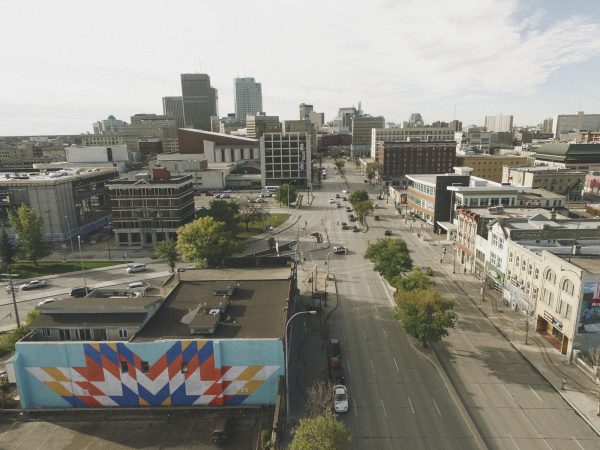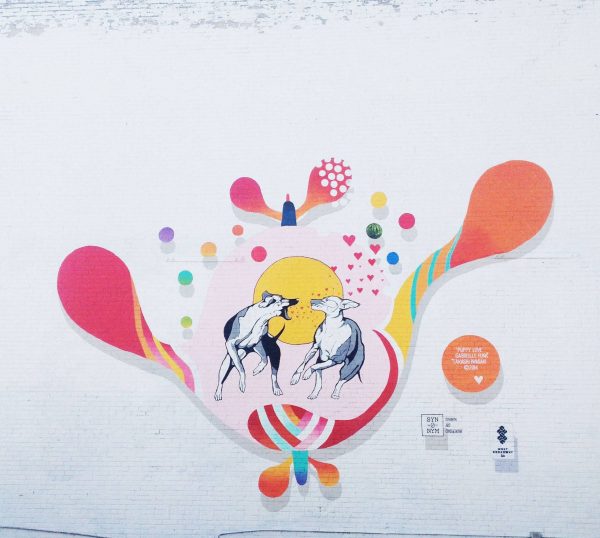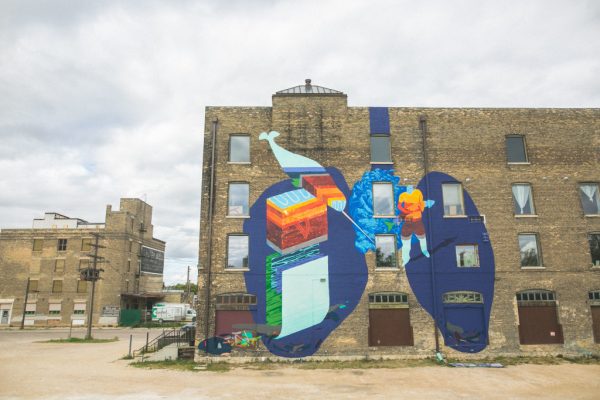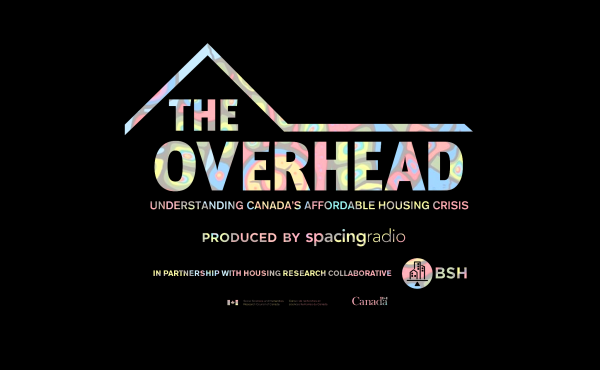
Interview by: Gill Baldwin
The Artful City series looks beyond Toronto in a new set of articles and interviews investigating public art practices and programs across the country.
For the first installment author Gill Baldwin spoke with the Winnipeg based Synonym Art Consultation, comprised of Chloe Chafe and Andrew Eastman. They are the duo behind some of Winnipeg’s newest and most innovative murals such as Kenneth Lavallee’s Star Blanket dedicated for Murdered and Missing Indigenous Women as well as the Wall-to-Wall Mural festival held annually in September. They talk about the motivation behind their work; their holistic approach to community building through mural making and why they believe a festival is the best form of community engagement.
Gill Baldwin: How did Synonym Art Consultation get started? Tell me about the reasons behind it?
Synonym Art Consultation: Synonym grew out of a desire to help young, emerging artists have a voice in Winnipeg’s contemporary art scene and, in turn, to make contemporary art more accessible to the public. We saw gaps both in the available opportunities for emerging artists to exhibit their work and also in art collections found in semi-public spaces around our city like restaurants, bars, and hair salons. We stepped in and started rotating curated art collections in these hospitality venues as if they were contemporary galleries. We also hosted unique events to celebrate each new collection.
GB: How did Synonym begin working on larger canvases outside of public establishments?
SAC: In a way, our vision and the public’s desire for programming outgrew the interior spaces that we were curating. We began to see the entire city as an even larger, more accessible gallery space, so the next logical step was to allow art to spill out the front doors and into the streets. While we, along with our team of artists, had little to no experience in painting murals, we mounted the first edition of Wall-to-Wall in 2014 and have since helped to nurture a contemporary street art scene and economy in our city.

GB: What is the Wall-to-Wall festival?
SAC: Our most ambitious undertaking to date is our annual mural and culture festival, Wall-to-Wall, which takes place in Winnipeg every year for the entire month of September. Since its inaugural year in 2014, it has seen the creation of multiple indoor and outdoor pieces of contemporary street art across the city and has celebrated each new work with distinctive events.
Many of these events include free, live, outdoor entertainment in order to both activate the murals and to showcase our city’s amazing musical talent alongside visual art. We focus primarily on the hip hop scene in Winnipeg, as it is really coming into its own alongside this contemporary street art movement. Hip hop and street art have always been intertwined art forms and we plan to continue to help develop both these scenes in our city.
Now, Synonym Art Consultation has its eye on more long-term goals for Wall-to-Wall, using it as a vehicle to help transform and establish visual identities for entire neighbourhoods. Most prominently, our activities are focussed in West Broadway, Winnipeg’s newest emerging artistic community, and The Dufferin Industrial Area, an under-utilized warehouse district in Winnipeg’s North End. In concentrating most of our efforts in these areas, our curatorial focus is honed on art activism and community-building through the creation of engaging works of contemporary street art that speak to the diversity of these communities and our province at large.

GB: You both are artists in other mediums and experiment in different fields, why did you choose murals as your focus? What are you views on the role of the muralist as the public artist? Is there something more accessible and immediate about murals?
SAC: When we started Synonym, we had no idea that we would end up here, with a month-long, annual mural festival. Looking back, however, there is a clear path forged by our desire to make contemporary art more accessible and to provide artists with employment opportunities that has led us to where we are today. Murals are the epitome of accessible art, by being incorporated into everyone’s daily life and helping to define the visual identity of their neighbourhoods. We strive to coax high-quality contemporary art out of the galleries and into the streets, to allow everyone to engage with it. Public art is just that, art for the public that belongs to us all through a sort of collective, shared ownership.
GB: How does the commissioning process work for the Wall-to-Wall festival? Do you approach artists or do they approach you?
SAC: Synonym Art Consultation has an advisory board made up of artists and experts who contribute to all facets of Wall-to-Wall, from curation, to outreach, to production. We generally approach artists, but are always excited and thankful when artists reach out to us to participate.
In terms of funding, we are graciously supported by our provincial arts council, as well as through grants at the municipal level. We have also developed diversity in our funding sources, in order to remain stable, through sponsorships, fundraising, but most importantly, through collaboration with other arts organizations and businesses in our city.
GB: Why the choice of establishing a festival as opposed to creating a board or organization that commissions a certain number of murals per year?
SAC: We feel that public art without community engagement and celebration often goes unnoticed and is under-appreciated. With all our projects, we encourage the public to come and witness the creation of the mural, to meet the artists, and to come to a community event, celebrating the official unveiling of the work. This way, the public is able to participate in a sort of collective ownership of each work, by creating memories and relationships with the murals and the artists.
GB: How does the festival format lend itself more naturally to this type of engagement? Is it about the concentration of work within a single time period? Is it the additional publicity a festival attracts?
SAC: By formatting our programming in the shape of a month-long festival, we allow each project to feed off the energy of the others. Seeing multiple boom lifts and scaffolding set up around our city with multiple works in progress attracts much more notice from the public and the media. We are also able to host multiple visiting artists over a very exciting month, giving them lots to see and do, as well as opportunities to engage with our community of artists and the public. More pragmatically, we can share resources between projects and events, including equipment, paint, and volunteers. It is a crazy month, but as it is said, the whole is greater than the sum of its parts!

GB: Could you tell me a little about the Winnipeg arts scene? Does Winnipeg have any other city wide artistic boards that regulate public art?
SAC: The Winnipeg Arts Council is the main regulator of Winnipeg’s official public art collection. However, many other progressive organizations see the value in public art, especially through the programming, mentorship, and employment opportunities it provides. Organizations that we often partner with, such as Art City Inc. and Graffiti Art Programming work primarily with youth to help train and showcase our city’s talented future artists. Otherwise, most individual neighbourhoods in our city have budgets put aside for public art through their Business Improvement Zone boards, some of which is now devoted to our organization, in order to help define visual identities for these communities.
GB: Do you think other cities and their existing infrastructure for public art have something to learn from the Wall-to-Wall festival?
SAC: We do feel that our model of celebrating art and culture in tandem with the creation of these murals has been very successful in allowing the public to truly feel connected to the works and to the broader project of developing a grassroots contemporary street art movement in our city, all while strengthening and beautifying communities. This model has also allowed us to diversify funding methods in order to provide even more exciting mentorship and employment opportunities to artists, performers, and workers in the cultural sector at large.
GB: Do you think that the Wall-to-Wall festival could work in other cities or is this a project that is uniquely suited to Winnipeg?
SAC: We have traveled to some of North America’s greatest hubs for contemporary street art on research trips, including Miami and Montreal, who both host massive mural festivals. We have been completely awestruck with the edgy, flashy styles and enormous scales of works in those cities as well as their festivities. These two cities have long and rich histories with contemporary street art and are therefore very well suited to host a mural festival.
In Winnipeg, as a more emerging force in this scene, we are able to define our own identity from the ground-up, taking into account hyper-local political, economic, and artistic viewpoints. That being said, developing this community has taken time and care and is now starting to truly take on an organic, powerful form.
GB: Has the festival attracted artistic talents from outside of Winnipeg?
SAC: Yes! In 2016 we hosted two artist collectives from Toronto – PA System and Clandestinos — as well as a young artist from Cape Dorset Nunavut. We have continued this national and international outreach by inviting some very prolific and exciting artists to come paint for Wall-to-Wall in 2017. Stay tuned.
GB: How much of a role does the community play in the mural making process? How important is that to you?
SAC: Each of our programs have different levels of public engagement. Some start with workshops with youth in order to steer the direction of the content of the mural, some involve youth and mentees actually painting the mural, and some involve artists from marginalized communities acting as assistants and contributors alongside featured artists.
GB: Indigenous artists and local community members seem to be very involved. Can you speak a little bit about this, and also can you tell me about the process behind Kenneth Lavallee’s Star Blanket project?
SAC: Kenneth Lavallee had been proposing The Star Blanket Project for a while, when we offered to step in to secure funding and permissions and to facilitate and promote the project as a part of Wall-to-Wall. Now it is a recurring annual project that aims to raise awareness around Missing and Murdered Indigenous Women, while draping our dilapidated Main Street with colourful, warm star blanket murals. Winnipeg, being the epicentre of MMIW, has the unique opportunity and responsibility to bring Indigenous issues to the forefront. The incredible wealth of Indigenous knowledge and artistic talent in our city is the cornerstone of our festival. We consult with local Indigenous elders on the content of our murals and make sure to offer opportunities to Indigenous artists in our city to participate in these important local, national, and international dialogues.

GB: Is there an Indigenous tradition of wall painting or mural making? Why has this become such an important medium for those communities?
SAC: As part of our 2017 programming, we will be teaming up once again with Niki Little, a local Indigenous curator, to explore this very notion. Her show “Landmarks,” will investigate the act of mark making as a way to investigate the intersecting points of land-based lineage, Indigenous territories, and histories found within our city that have been overlooked. She hopes this exhibition will become a space that is a form of generative process and resistance revealing the nuanced complexity of Indigenous narrative within civic pride. The theme of this show will resonate in a tangible, long-term sense outside of the exhibition space in the form of the new murals, which serve as new landmarks and wayfinding tools within our city.
GB: Lastly are there future plans for the Wall-to-Wall festival and Synonym Art Consultation?
SAC: We hope to see Wall-to-Wall to continue to grow and to put Winnipeg on the map as a hub for contemporary street art with a unique voice. We are now being offered opportunities to define visual identities for entire neighbourhoods, which is an exciting prospect. Specifically, along with many of our partners, we hope to help develop an under-utilized warehouse district in our city into a thriving artistic community, covered in works of contemporary street art and full of artist studios, galleries, event venues, and affordable housing. We want to show that innovative, sustainable, and ethical economic development rooted in the arts can help to build strong communities and to better our city as a whole.

Gill Baldwin is a writer, designer and interior architect currently based out of Toronto.
The Artful City is a Toronto-based collective that convenes discussions about the role of public art in Toronto through research and public engagement and creates space for more diverse and inclusive practices.




